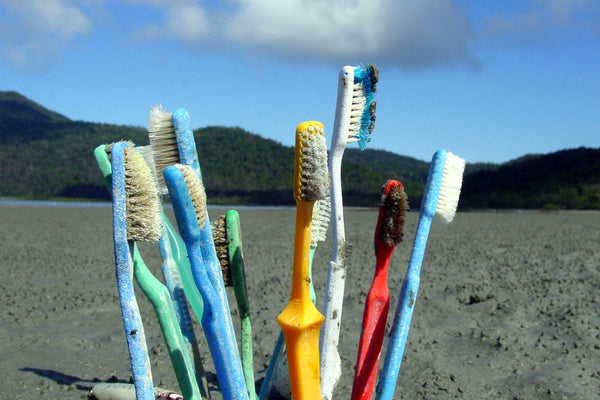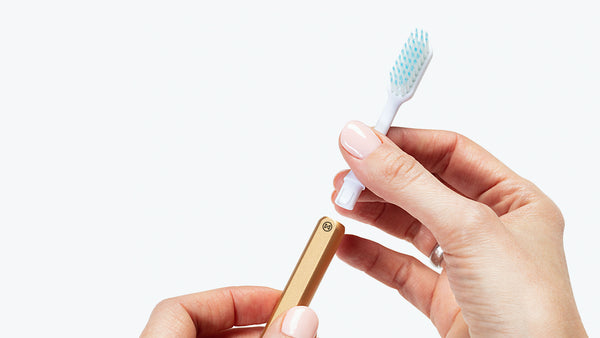Welcome to the definitive guide to the most sustainable toothbrushes. In this article we compare and grade electric, disposable, bamboo and eco-friendly toothbrushes with metal handles.
Here’s a scary fact: every disposable plastic toothbrush ever made is on the planet today and will be for centuries. The exact number of years isn’t known, but a safe bet is at least 400 years.
Ok, but how many can there be?
Every year around one billion disposable toothbrushes get thrown away in the US alone. And according to this article in National Geographic, if we extrapolate that number for the entire planet, it’s likely that more than twenty billion toothbrushes get tossed every year.
If you lay one billion plastic toothbrushes end-to-end they would circle the earth more than four times. I think we can all agree that’s far from fantastic.
So which toothbrush is the most sustainable?
Let’s dig in…
The Contestants
- Electric toothbrushes
- Disposable plastic toothbrush
- Bamboo toothbrushes
- Nada toothbrush
We’ll compare these four categories of toothbrushes since they're the most commonly used today.
We could have gone way back and reviewed the earliest toothbrushes (and also the most sustainable) miswak branches, but they just don't have the cachet they did 7,000 years ago.
The Criteria
- Manufacturing
- Materials
- Lifecycle
It's important when looking at the sustainability of a toothbrush to look at not just the product itself, but the amount of energy that went into making it and the amount of waste each produces. There are other considerations such as shipping and packaging, but with so many variables, we’re keeping our criteria to the three points mentioned above.
Our grading system ranges from A (great!) to D (rotten!).
Note: this article is not looking at oral care and which toothbrush is the best for you! This is strictly about sustainability.
Ok, here we go!
1. Electric Toothbrushes

Manufacturing
As you can see from the photo above, electric toothbrushes have a lot of parts.
The manufacturing process of electric toothbrushes is clearly much, much more involved than any manual toothbrush.
The batteries alone make electric toothbrushes a poor choice in terms of sustainability because batteries rarely get recycled and end up in landfill. And this is happening at a time when we could be using them to power electric cars, rather than toothbrushes…

Materials
There is a mix of plastic, metal, rubber, nylon, wires, and more in electric toothbrushes. Very little of this material is recyclable at all, not to mention that the separation of the materials to recycle them would never happen as it’s too difficult.
So as far as the materials go, this is a big fail…

Lifecycle
It’s tough to find data on how long electric toothbrushes last. This isn't something we as a society generally measure (maybe we should!). Some quick internet research reveals that 3 – 5 years seems to be the expected lifespan.
If people use their electric toothbrush for that amount of time before throwing it away, then there is a lot of waste hitting landfills.
The brush heads are mostly made of several plastics fused together, meaning they are nearly impossible to recycle.
So while these brush heads may use less plastic per brush than disposables, they are still being sent to landfill, which is not ideal.

–
Overall Electric Toothbrush Sustainability Score
Electric toothbrushes have extremely high manufacturing costs, use materials that aren’t eco friendly and create waste through batteries and brush heads making them a pretty bad choice.

2. Disposable Plastic Toothbrushes

Manufacturing
Plastic toothbrushes are made by injection molding plastic into a steel mold. Depending on the toothbrush, several plastics may be fused together to add grip or just enhance the appearance. Let’s be honest here, if you need special grippy plastic to hold your toothbrush, you're probably brush way too hard. Stop now before your gums recede into nothing.
To see how plastic toothbrushes are made, check out this video. The machine that adds bristles is pretty amazing.
So while the energy consumption to make plastic toothbrushes is fairly low, it’s in the materials where things start to turn ugly…

Materials
Plastic toothbrushes were first produced in 1938. At the time they were revolutionary, bringing affordable oral care to the masses.
Plastic is actually a miraculous material. It’s cheap to produce, easy to manufacture into almost anything and is incredibly durable. There are two major issues with plastic; first, we use it way too much. We should only use it when other more sustainable materials just don't work. The second issue is that because it’s so durable, once discarded it lasts for centuries.
How long? We don't know as it’s been in widespread use for less than a century. This infographic shows the estimated lifespan of some common plastic objects.
Most plastics are of course made from fossil fuels and therefore are not good for the earth. This is why you might be hearing so much about eliminating single use plastics. Once they end up in landfills or oceans, they slowly leach chemicals into the ecosystem, which have now been found in pretty much everything, including human blood.

Lifecycle
I've touched on this a few times already in this article, but it’s worth repeating: Plastic lasts a very, very long time.
For use in toothbrushes, as in other single use applications, plastic is a bad choice unless there is a plan in place to minimize it or recycle it. Toothbrushes are meant to last three months of actual brushing time, so it makes little sense that they then spend 400+ years in landfill.

–
Overall Disposable Plastic Toothbrush Score
So all in all, disposable plastic toothbrushes are easy to make, but most are not recyclable and spend a century in landfill for every month of we actually use them. This, dear reader, does not make sense to me.

3. Bamboo Toothbrushes

Manufacturing
Making bamboo toothbrushes has some of the same processes as plastic ones, especially the bristle insertion.
In this video, you can see the process to cut and sand the handles.
Bamboo may be a bit more energy intensive due to the up front work of harvesting the bamboo and preparing it to make the handles, but that cost is offset by other factors…
Materials
This is where bamboo (mostly) gets a good grade… Bamboo is not a tree, but actually a member of the grass family. It’s among the fastest growing plants on earth, growing up to 36 inches in 24 hours!
So as far as materials go, bamboo is fast-growing, natural and therefore sustainable.
The issue with many bamboo toothbrushes however, isn’t the handle, it’s the bristles… Wait. What’s that, you ask?
Most bamboo toothbrushes use plastic bristles (usually nylon). This is because nylon is the best bristle material for our teeth. But good for our teeth doesn’t always mean good for the earth.
While it may feel better throwing a bamboo toothbrush away than a disposable plastic one, the sad truth is that unless your bristles are natural (such as pig or boars hair or castor bean oil), once the handle decomposes the plastic bristles will be released and pollute the environment. And bristles are tiny. Because of that they can easily end up in nature where will cause havoc for wildlife.
So when choosing a bamboo toothbrush, it’s important to choose one with natural bristles if your goal is being eco friendly.

Lifecycle
If you were to toss your bamboo toothbrush into your garden, it would take between 5 – 10 years to decompose.
You can speed that up to 2 – 3 months by putting it into a home composter.
So bamboo gets a good lifecycle grade for the handle, but loses points for the ones that use plastic bristles. (If your use bamboo and the packaging makes claims of "all natural", "biodegradable" or "compostable," check to make sure the bristles aren’t plastic.)
–
Overall Bamboo Toothbrush Score
Bamboo toothbrushes are a very eco-friendly option and well worth your consideration. Make sure to look for bamboo toothbrushes with natural bristles to ensure you’re not tossing plastic bristles away in the name of sustainability.

4. Nada Toothbrush

Manufacturing
Nada toothbrush was designed to reduce the amount of plastic being used. The handle is made of aluminum and the brush heads are made of plastic.
To manufacture the handles, the aluminum is first extruded into the tubular shape. Extrusion is where heated aluminum is pushed through a mold, resulting in the final rough shape.
After the extrusion process, the handles are machined to create the rounded end shapes and the hole where the brush heads are inserted.
Finally, the handles are sand blasted to create a soft, easy-to-hold finish and then anodized. Anodizing is a process to harden and colour the surface of the handles. The colour actually becomes part of the aluminum, which means there is no painting or powder coating (ie. extra chemicals) added.
Nada’s eco-friendly toothbrush heads are made using the same process as plastic disposables. The brush heads are made by injection molding plastic and then the bristles are added afterwards.
Because Nada has two parts, it requires more energy to produce than either plastic or bamboo toothbrushes, but less than electric.

Materials
Aluminum is the third most abundant element found on earth (after oxygen and silicon). It is lightweight, easy to fabricate and best of all is infinitely recyclable without losing quality.
We chose aluminum for the following reasons:
- It’s lighter than most other metals (great for transportation)
- Aluminum is safe to use
- It’s more durable than plastic and wood
- It can be recycled forever and not ‘downcycled’ as so many other materials are
- It doesn’t collect germs or mold in a damp bathroom environment
- It can be brightly coloured without the use of paints or powder coating
Nada’s brush heads are currently made with polypropylene plastic and nylon bristles.
We explored and tested PLA (polyactic acid), which is made with renewable resources and is compostable in industrial composters. We decided against it for a few reasons; it wasn’t strong enough for use in toothbrush heads, and, municipal composting is not widespread enough at this point in time. And even if every municipality had a composting program, finding bristles which are compostable proved a challenge. (Note: we do take back our customers used brush heads and send them to TerraCycle to be completely recycled.)
While aluminum is the perfect choice for a toothbrush handle, the use of plastic for the brush heads lowers the mark a touch.

Lifecycle
Here’s where Nada shines. Using the aluminum handle for life means that the bulk of the material used in a disposable or bamboo toothbrush doesn’t need to be sourced, manufactured, shipped and disposed of every three months.
This means huge savings in terms of resources used—not only the material but the energy for production, shipping, storage, etc.
And while plastic is still plastic, we take back our brush heads and send them to TerraCycle to be recycled into plastic pellets, which are then resold for use in other products.
Therefore the waste from Nada toothbrushes can really be measured only in manufacturing waste. This is what makes Nada toothbrush unique and a great choice for both sustainability and oral care.

–
Overall Nada Toothbrush Score
Nada toothbrush uses less material than other toothbrushes. The plastic replacement toothbrush heads get recycled (as long as customers return them) so there is very little plastic waste. Overall, Nada is a great choice for a sustainable manual toothbrush.

–
Thanks for reading our guide to the most sustainable toothbrushes! We’d love your feedback so be sure to leave a comment below.
Simon




